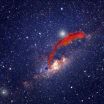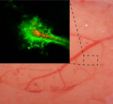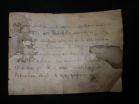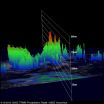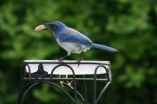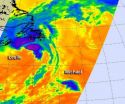(Press-News.org) At first glance, the center of the Milky Way seems like a very inhospitable place to try to form a planet. Stars crowd each other as they whiz through space like cars on a rush-hour freeway. Supernova explosions blast out shock waves and bathe the region in intense radiation. Powerful gravitational forces from a supermassive black hole twist and warp the fabric of space itself.
Yet new research by astronomers at the Harvard-Smithsonian Center for Astrophysics shows that planets still can form in this cosmic maelstrom. For proof, they point to the recent discovery of a cloud of hydrogen and helium plunging toward the galactic center. They argue that this cloud represents the shredded remains of a planet-forming disk orbiting an unseen star.
"This unfortunate star got tossed toward the central black hole. Now it's on the ride of its life, and while it will survive the encounter, its protoplanetary disk won't be so lucky," said lead author Ruth Murray-Clay of the CfA. The results are appearing in the journal Nature.
The cloud in question was discovered last year by a team of astronomers using the Very Large Telescope in Chile. They speculated that it formed when gas streaming from two nearby stars collided, like windblown sand gathering into a dune.
Murray-Clay and co-author Avi Loeb propose a different explanation. Newborn stars retain a surrounding disk of gas and dust for millions of years. If one such star dived toward our galaxy's central black hole, radiation and gravitational tides would rip apart its disk in a matter of years.
They also identify the likely source of the stray star - a ring of stars known to orbit the galactic center at a distance of about one-tenth of a light-year. Astronomers have detected dozens of young, bright O-type stars in this ring, which suggests that hundreds of fainter Sun-like stars also exist there. Interactions between the stars could fling one inward along with its accompanying disk.
Although this protoplanetary disk is being destroyed, the stars that remain in the ring can hold onto their disks. Therefore, they may form planets despite their hostile surroundings.
As the star continues its plunge over the next year, more and more of the disk's outer material will be torn away, leaving only a dense core. The stripped gas will swirl down into the maw of the black hole. Friction will heat it to high enough temperatures that it will glow in X-rays.
"It's fascinating to think about planets forming so close to a black hole," said Loeb. "If our civilization inhabited such a planet, we could have tested Einstein's theory of gravity much better, and we could have harvested clean energy from throwing our waste into the black hole."
INFORMATION:
Planets can form in the galactic center
2012-09-12
ELSE PRESS RELEASES FROM THIS DATE:
Improved nanoparticles deliver drugs into brain
2012-09-12
The brain is a notoriously difficult organ to treat, but Johns Hopkins researchers report they are one step closer to having a drug-delivery system flexible enough to overcome some key challenges posed by brain cancer and perhaps other maladies affecting that organ.
In a report published online on August 29 in Science Translational Medicine, the Johns Hopkins team says its bioengineers have designed nanoparticles that can safely and predictably infiltrate deep into the brain when tested in rodent and human tissue.
"We are pleased to have found a way to prevent drug-embedded ...
Newly discovered letters and translated German ode expand Texas link to infamous Bone Wars
2012-09-12
In the late 1800s, a flurry of fossil speculation across the American West escalated into a high-profile national feud called the Bone Wars.
Drawn into the spectacle were two scientists from the Lone Star State: geologist Robert T. Hill, now acclaimed as the Father of Texas Geology, and naturalist Jacob Boll, who made many of the state's earliest fossil discoveries.
Hill and Boll had supporting roles in the Bone Wars through their work for one of the feud's antagonists, Edward Drinker Cope. A new study by vertebrate paleontologist Louis L. Jacobs at Southern Methodist ...
Scripps Research scientists devise powerful new method for finding therapeutic antibodies
2012-09-12
LA JOLLA, CA, September 11, 2012 – Scientists at The Scripps Research Institute have found a new technique that should greatly speed the discovery of medically and scientifically useful antibodies, immune system proteins that detect and destroy invaders such as bacteria and viruses. New methods to discover antibodies are important because antibodies make up the fastest growing sector of human therapeutics; it is estimated that by 2014 the top-three selling drugs worldwide will be antibodies.
The new technique, described in an article this week published online ahead of ...
Ageism presents dilemmas for policymakers worldwide
2012-09-12
The negative consequences of age discrimination in many countries are more widespread than discrimination due to race or gender, yet differential treatment based on a person's age is often seen as more acceptable and even desirable, according to the newest edition of the Public Policy & Aging Report (PP&AR). This publication, which features cross-national perspectives, was jointly produced by The Gerontological Society of America (GSA) and AGE UK.
The PP&AR explores how discriminatory behaviors manifest themselves, steps that are being taken to address those behaviors, ...
Sliding metals show fluidlike behavior, new clues to wear
2012-09-12
"We see phenomena normally associated with fluids, not solids," said Srinivasan Chandrasekar, a professor of industrial engineering at Purdue University, working with postdoctoral research associates Narayan Sundaram and Yang Guo.
Numerous mechanical parts, from bearings to engine pistons, undergo such sliding.
"It has been known that little pieces of metal peel off from sliding surfaces," Chandrasekar said. "The conventional view is that this requires many cycles of rubbing, but what we are saying is that when you have surface folding you don't need too many cycles for ...
NASA's Global Hawk investigating Atlantic Tropical Depression 14
2012-09-12
NASA's Hurricane and Severe Storm Sentinel (HS3) airborne mission sent an unmanned Global Hawk aircraft this morning to study newborn Tropical Depression 14 in the central Atlantic Ocean that seems primed for further development. The Global Hawk left NASA's Wallops Flight Facility on Wallops Island, Va., this morning for a planned 26-hour flight to investigate the depression.
NASA's latest hurricane science field campaign began on Sept. 7 when the Global Hawk flew over Hurricane Leslie in the Atlantic Ocean. HS3 marks the first time NASA is flying Global Hawks from the ...
Scrub jays react to their dead
2012-09-12
Western scrub jays summon others to screech over the body of a dead jay, according to new research from the University of California, Davis. The birds' cacophonous "funerals" can last for up to half an hour.
Anecdotal reports have suggested that other animals, including elephants, chimpanzees and birds in the crow family, react to dead of their species, said Teresa Iglesias, the UC Davis graduate student who carried out the work. But few experimental studies have explored this behavior.
The new research by Iglesias and her colleagues appears in the Aug. 27 issue of ...
Protein linked to therapy resistance in breast cancer
2012-09-12
A gene that may possibly belong to an entire new family of oncogenes has been linked by researchers with the U.S. Department of Energy (DOE)'s Lawrence Berkeley National Laboratory (Berkeley Lab) to the resistance of breast cancer to a well-regarded and widely used cancer therapy.
One of the world's leading breast cancer researchers, Mina Bissell, Distinguished Scientist with Berkeley Lab's Life Sciences Division, led a study in which a protein known as FAM83A was linked to resistance to the cancer drugs known as EGFR-TKIs (Epidermal Growth Factor Receptor-Tyrosine Kinase ...
What are the effects of the Great Recession on local governments?
2012-09-12
Freezing positions and cutting workforces
Trimming pension and health care costs and passing them to employees
Lowering service delivery levels, but not imposing many new fees
Using technology to reduce costs where possible
Receiving added pressure but little help from States and the Federal Government
This important new research sheds light on the challenges faced by city and county governments that must provide most basic services. Unlike federal or state governments, these local governments have limited ability to generate revenue and are often mandated to pay for ...
NASA infrared data reveals fading Tropical Storm Leslie and peanut-shaped Michael
2012-09-12
When NASA's Aqua satellite passed over the Atlantic on Sept. 11 it caught Tropical Storm Leslie's clouds over Newfoundland and peanut-shaped Tropical Storm Michael to its southwest. The Atmospheric Infrared Sounder (AIRS) instrument captured infrared data on Tropical Storms Leslie and Michael when it passed overhead on Sept. 11.
Michael Appears Peanut-Shaped on Satellite Imagery
Tropical Storm Michael forecast to become a remnant low later today, Sept. 11, but as of 11 a.m. EDT Michael still had maximum sustained winds near 45 mph (75 kmh). It was located about 1,090 ...
